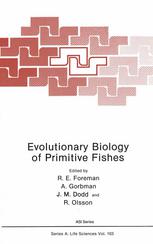What, precisely, is a primitive fish? Most biologists would agree that the living cyclostomes, selachians, crossopterygians, etc. cannot be considered truly primitive. However, they and the fossil record have served to provide the information which forms the basis for speculation concerning the nature of the original vertebrates. This symposium of biologists from a variety of disciplines was called together to create collectively, from the best available current evidence, a picture of the probable line of evolution of the prototype primitive fishes. The symposium was designed to follow one that took place in Stockholm in 1967, convened for a similar purpose, with about the same number of participants. It is a matter of interest that almost the entire 1967 symposium (Nobel Symposium 4) dealt only with the hard tissues, whether fossil or modern. In charting the course of the present symposium it was felt that the intervening years have produced numerous lines of new evidence that could be employed in the same way that a navigator determines his position. Each field, be it adult morphology, geology, ecology, biochemistry, development or physiology, generates evidence that can be extrapolated backward from existing vertebrate forms and forward from invertebrate forms. If the intersect of only two lines of evidence produces a navigational “fix” of rather low reliability, then an intersect, however unfocussed, of multiple guidelines from more numerous disciplines might provide a better position from which to judge early vertebrate history.
Biology
[PDF] Evolutionary Biology of Primitive Fishes Carl Gans (auth.), R. E. Foreman, A. Gorbman, J. M. Dodd, R. Olsson (eds.)
$19.99






Reviews
There are no reviews yet.